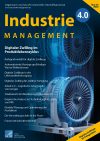Search


Bibtex
Cite as text
@Article{Saske+Schwoch+Paetzold+Layer+Neubert+Leidich+Robl,
Cite-key = "Saske2022",
Year= "2022",
Number= "5",
Volume= "IM 38",
Pages= "21-24",
Journal = "Industrie 4.0 Management",
Title= "Digitale Abbilder als Basis Digitaler Zwillinge im Anlagenbau: Besonderheiten, Herausforderungen und Lösungsansätze",
Author= "Bernhard Saske, Sebastian Schwoch, Kristin Paetzold, Technische Universität Dresden,
Max Layer, Sebastian Neubert, Siemens Energy Global GmbH & Co.KG,
Jonathan Leidich und Peter Robl, Siemens AG",
Doi= "https://doi.org/10.30844/IM_22-5_21-24",
Abstract= "Die Nutzung Digitaler Zwillinge birgt vielfältige Anwendungsfälle und Chancen
zur Optimierung von Prozessen entlang des gesamten Lebenszyklus
technischer Systeme. Jedoch trifft das Konzept im Anlagenbau auf spezifische
Besonderheiten innerhalb der Entwicklung, der Errichtung sowie dem Betrieb
der Anlagen. Dieser Beitrag erläutert diese Besonderheit und die daraus folgenden
Herausforderungen für die Erstellung und die Anwendung Digitaler
Zwillinge im Anlagenbau. Als Lösungsansatz wird das Digitale Abbild als
Grundlage Digitaler Zwillinge sowie dessen Konzept, Voraussetzungen und
Potenziale vorgestellt.",
Keywords= "Digitaler Zwilling, Digitales Abbild, Anlagenbau",
}
Bernhard Saske, Sebastian Schwoch, Kristin Paetzold, Technische Universität Dresden,
Max Layer, Sebastian Neubert, Siemens Energy Global GmbH & Co.KG,
Jonathan Leidich und Peter Robl, Siemens AG(2022): Digitale Abbilder als Basis Digitaler Zwillinge im Anlagenbau: Besonderheiten, Herausforderungen und Lösungsansätze. IM 385(2022), S. 21-24. Online: https://doi.org/10.30844/IM_22-5_21-24 (Abgerufen 03.12.25)
Open Access
Abstract
Abstract
Die Nutzung Digitaler Zwillinge birgt vielfältige Anwendungsfälle und Chancen zur Optimierung von Prozessen entlang des gesamten Lebenszyklus technischer Systeme. Jedoch trifft das Konzept im Anlagenbau auf spezifische Besonderheiten innerhalb der Entwicklung, der Errichtung sowie dem Betrieb der Anlagen. Dieser Beitrag erläutert diese Besonderheit und die daraus folgenden Herausforderungen für die Erstellung und die Anwendung Digitaler Zwillinge im Anlagenbau. Als Lösungsansatz wird das Digitale Abbild als Grundlage Digitaler Zwillinge sowie dessen Konzept, Voraussetzungen und Potenziale vorgestellt.
Keywords
Schlüsselwörter
Digitaler Zwilling, Digitales Abbild, Anlagenbau
References
Referenzen
[1] VanDerHorn, E.; Mahadevan, S.: Digital Twin: Generalization, characterization and implementation. In: Decision Support Systems 145 (2021). DOI: https://doi.org/10.1016/j.dss.2021.113524
[2] Stark, R.; Anderl, R.; Thoben, K.-D.; Wartzack, S.; Krause, F.-L.; Grässler, I.; Pottebaum, J.; Schleich, B.; Stelzer, R.; Hick, H.; Klein, P.; Saske, B.; Gerhard, D.; Czwick, C.; Gogineni, S.; Klimmeck, L.; Bajzek, M.; Jacobs, G.; Berroth, J.; Zimmermann, T.; Kranabitl, P.; Kirchner, E.; Göckel, N.: WiGeP-Positionspapier: „Digitaler Zwilling “. Zeitschrift für wirtschaftlichen Fabrikbetrieb 115 (2020). DOI: https://doi.org/10.1007/978-3-64235950-7_16870-1
[3] Melesse, T.Y.; Di Pasquale, V.; Riemma, S.: Digital Twin models in industrial operations: State‐of‐the‐art and future research directions. In: IET collob. intell. manuf. 3 (2021) 1. S. 37 – 47. DOI: https://doi.org/10.1049/cim2.12010
[4] Uhlemann, T.H.-J.; Lehmann, C.; Steinhilper, R.: The Digital Twin: Realizing the Cyber-Physical Production System for Industry 4.0. In: Procedia CIRP 61 (2017). S. 335 – 340. DOI: https://doi.org/10.1016/j.procir.2016.11.152
[5] Rasheed, A.; San, O.; Kvamsdal, T.: Digital Twin: Values, Challenges and Enablers From a Modeling Perspective. In: IEEE Access 8 (2020). S. 21980 – 22012. DOI: https://doi.org/10.1109/ACCESS.2020.2970143
[6] Güntner, G.; Hoher, S.: Digital Twins im Anlagen-Lebenszyklus. White Paper. Digital Transfer Zentrum–Salzburg (2020). URL: https://www.salzburgresearch.at/publikation/digital-twins-im-anlagen-lebenszyklus/
[7] Alves de Araujo Junior, C.A.; Mauricio Villanueva, J.M.; Almeida, R.J.S. de; Azevedo de Medeiros, I.E.: Digital Twins of the Water Cooling System in a Power Plant Based on Fuzzy Logic. In: Sensors (Basel, Switzerland) 21 (2021). DOI: https://doi.org/10.3390/s21206737
[8] Lu, Q.; Xie, X.; Parlikad, A.K.; Schooling, J.M.: Digital twin-enabled anomaly detection for built asset monitoring in operation and maintenance. In: Automation in Construction 118 (2020). DOI: https://doi.org/10.1016/j.autcon.2020.103277
[9] Dawes, W.N.; Meah, N.; Kudryavtsev, A.; Evans, R.; Hunt, M.; Tiller, P.: Digital Geometry to Support a Gas Turbine Digital Twin. In: AIAA Scitech 2019 Forum (2019). DOI: https://doi.org/10.2514/6.2019-1715
[10] Wagner, C.; Grothoff, J.; Epple, U.; Drath, R.; Malakuti, S.; Gruner, S.; Hoffmeister, M.; Zimermann, P.: The role of the Industry 4.0 asset administration shell and the digital twin during the life cycle of a plant. In: 2017 22nd IEEE International Conference on Emerging Technologies and Factory (2017). DOI: https://doi.org/10.1109/ETFA.2017.8247583
[11] Bergs, T.; Gierlings, S.; Augspurger, T.: Mit dem Digitalen Zwilling Prozessgrenzen überwinden. In: Internet of Production – Turning Data into Value: Statusberichte der Produktionstechnik (2020). S. 81 – 113. DOI: https://doi.org/10.24406/ipt-n-589615
[12] Pettey, C.: Prepare for the impact of digital twins. Gartner (2017). URL: https://www.gartner.com/smarterwithgartner/prepare-for-the-impact-of-digital-twins, Abrufdatum 17.08.2022
[13] Siltanen, P.; Karhela, T.; Woodward, C.; Savioja, P.: Augmented Reality for Plant Life cycle Management. In: 2007 IEEE International Technology Management Conference (ICE) (2007). S. 1 – 8.
[14] Siltanen, P.; Pärnänen, A.: Comparison of data models for plant lifecycle information management. In: Leading the Web in Concurrent Engineering (2006). S. 346 – 353.

 English
English
